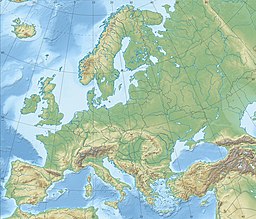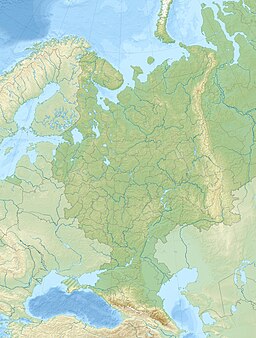
Back Peipusmeer Afrikaans Peipussee ALS بحيرة بيبوس Arabic بحيره بيبوس ARZ Llagu Peipus AST Чуд-Псков күле Bashkir Чудска-Пскоўскае возера Byelorussian Чудзка-Пскоўскае возера BE-X-OLD Чудско-Псковско езеро Bulgarian Lenn Peipsi Breton
| Lake Peipus | |
|---|---|
 Landsat satellite photo | |
Location within Baltic Sea region | |
| Location | Estonia, Russia |
| Coordinates | 58°41′N 27°29′E / 58.683°N 27.483°E |
| Primary inflows | Velikaya, Emajõgi, Avijõgi |
| Primary outflows | Narva |
| Catchment area | 47,800 km2 (18,500 sq mi) |
| Basin countries | Estonia, Latvia, and Russia |
| Surface area | 3,555 km2 (1,373 sq mi) |
| Average depth | 7.1 m (23 ft) |
| Max. depth | 15.3 m (50 ft) |
| Water volume | 25 km3 (6.0 cu mi) |
| Shore length1 | 520 km (320 mi) |
| Surface elevation | 30 m (98 ft) |
| Islands | Kamenka, Kolpina, Piirissaar |
| Settlements | Kallaste, Mustvee |
| 1 Shore length is not a well-defined measure. | |
Lake Peipus[1][a] is the largest trans-boundary lake in Europe, lying on the international border between Estonia and Russia.[2]
The lake is the fifth-largest in Europe after Lake Ladoga and Lake Onega (in Russia), Lake Vänern (in Sweden), and Lake Saimaa (in Finland).[3]
It covers 3,555 km2 (1,373 sq mi), and it has an average depth of 7.1 m (23 ft), the deepest point being 15 m (49 ft).[4][5] The lake has several islands and consists of three parts:[6]
- Lake Peipus / Chudskoye (Estonian: Peipsi järv, Russian: Чудское озеро), the northern part of the lake, with an area of 2,611 km2 (1,008 sq mi) (73%)
- Lake Pihkva / Pskovskoye (Estonian: Pihkva järv, Russian: Псковское озеро), the southern part of the lake (area 708 km2 (273 sq mi) or 20%)
- Lake Lämmi / Tyoploye (Estonian: Lämmijärv, Russian: Тёплое озеро), the sound connecting the other two parts of the lake (area 236 km2 (91 sq mi) or 7%)
The lake is used for fishing and recreation, but suffered from environmental degradation from Soviet-era agriculture. Some 30 rivers and streams discharge into Lake Peipus, the two largest of which are the Velikaya and Emajõgi. The lake drains into the Gulf of Finland via the Narva River.
On 5 April 1242, the frozen lake was the site of the Battle on the Ice (also known as the Battle of Lake Peipus) between the armies of the Novgorod Republic and the Teutonic Order.
- ^ Lake Peipus. Encyclopædia Britannica online
- ^ Lake Peipus. Encyclopædia Britannica online
- ^ The whispering waters of Estonia – Visit Estonia
- ^ Чудско-Псковское озеро, Great Soviet Encyclopedia
- ^ (in Russian) Russian lakes with area of more than 350 km². (GIF table). Retrieved on 2012-01-21.
- ^ Gulnara Roll; Robben Romano (2001). "Challenges and opportunities for Development of an Effective Transboundary Water Management Regime in the Lake Peipus Basin: The Estonian–Russian Border Area". In Ganster, Paul (ed.). Cooperation, Environment, and Sustainability in Border Regions. San Diego: San Diego State University Press. p. 288.
Lake Peipus .... consists of three unequal parts: northern Lake Peipus ...; southern Lake Pskov ...; and the narrow, strait-like Lake Lämmi
Cite error: There are <ref group=lower-alpha> tags or {{efn}} templates on this page, but the references will not show without a {{reflist|group=lower-alpha}} template or {{notelist}} template (see the help page).


